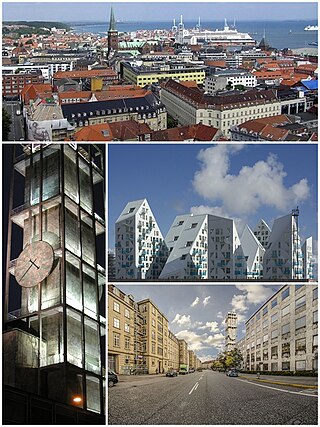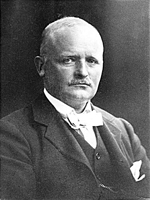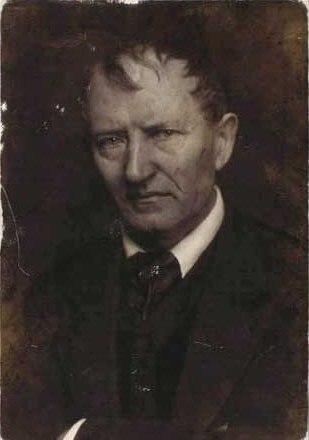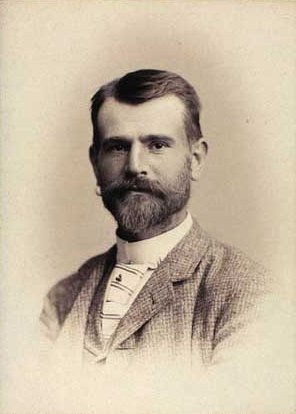
Aarhus is the second-largest city in Denmark and the seat of Aarhus Municipality. It is located on the eastern shore of Jutland in the Kattegat sea and approximately 187 kilometres (116 mi) northwest of Copenhagen.

The Ceres Brewery was a beer and soft drink producing facility in Århus, Denmark, that operated from 1856 until 2008. Although the brewery was closed by its owner Royal Unibrew the Ceres brand continues, with the product brewed at other facilities. The area where the brewery stood is being redeveloped for residential and commercial use and has been named CeresByen.

Aarhus Stadium is an association football stadium in Aarhus, Denmark which has been the home ground of Aarhus Gymnastikforening since the 1920s. With a current capacity of 19,433, it is the third largest football stadium of any football team in Denmark. It is part of the sports complex, known as Aarhus Sports Park, that is run by Ceres Park & Arena.

Hack Kampmann was a Danish architect, Royal Inspector of Listed State Buildings in Jutland and professor at the architecture department of the Royal Danish Academy of Fine Arts. Marselisborg Palace in Aarhus, built between 1899 and 1902, is among his best known works.

Aarhus Central Station is the main railway station serving the city of Aarhus, Denmark. Serving as the main connecting hub for rail traffic between Aarhus and the rest of Denmark, the station is used by an average of 6.3 million people per year, making it the busiest station in Denmark outside the Copenhagen area. It is located in the city centre between the districts of Midtbyen and Frederiksbjerg with entrances from Banegårdspladsen and the shopping centre Bruun's Galleri, and with access to platforms from M.P. Bruuns Gade.

Anton Rosen was a Danish architect, furniture designer, decorative artist and professor at the Royal Danish Academy of Fine Arts. In his architecture, he combined a free Historicist style with inspiration from contemporary English architecture and details influenced by Jugendstil.
Frederick George "Fritz" Clausen (1848–1940) was a Danish-born architect who came to the United States in 1869 and founded an architectural practice in Davenport, Iowa. The firm that he founded, presently named Studio 483 Architects, is still in business today, the oldest firm in continuous practice in the state of Iowa. Clausen has been termed the "premier 19th century architect" of Davenport, Iowa.

Thomas Arboe was a Danish architect.

Emil Axel Berg was a Danish architect. He received the Neuhausen Prize, C. F. Hansen Medal, and Eckersberg Medal, and was honored as a Knight of Order of the Dannebrog.

Alf Cock-Clausen was a Danish architect. He was active during the transition from Neoclassicism to Functionalism and many of his works show influence from Art Deco. His factory for the distillery De Danske Spritfabrikker at Aalborg's harbour front was declared a Danish Industrial Heritage Site in 2009.

CeresByen is a neighbourhood in Midtbyen, a district of the city of Aarhus, Denmark. It is a mixed residential and commercial area, comprising the site of the former Ceres Brewery operating here from 1856 until November 2008. The outer edges of CeresByen are defined by the streets Thorvaldsensgade, Silkeborgvej, Dollerupvej and Ceres Allé.
The following is a timeline of the history of the city of Aarhus, a city in central Denmark.

Nordre Cemetery is a cemetery in Aarhus, Denmark. It was established in 1876, east of Aarhus University and Aarhus University Hospital by Nørrebrogade.

Thorkel Luplau Møller was a Danish architect who primarily worked in and around Aarhus at the turn of the 20th century. Stylistically he worked in the National Romantic style and later Baroque Revival.

Christian Frühstück Nielsen was a Danish architect born in Aarhus, Denmark on 7 August 1878. Frühstück Nielsen primarily worked in and around Aarhus and on Mors where he left numerous lasting works.

Willemoe's House or the Bishop's House (Bispegården) is a building in Aarhus, Denmark situated in the Indre By neighborhood on the corner of Fredensgade and Sønder Alle. Willemoe's House was built in 1858 by designs of the German architect Gustav Ludolf Martens in historicist Gothic revival style. Originally it was built to serve as the home and office for the bailif of Hads and Ning Hundred and today houses the Danish non-profit Folkeligt Oplysningsforbund (FOF).

The architecture of Aarhus comprises numerous architectural styles and works from the Middle Ages to present-day. Aarhus has a well-preserved medieval city center with the oldest dwellings dating back to the mid-1500s and some ecclesiastical structures such as St. Clemen's Cathedral and numerous smaller churches that can be traced back to the 1100s. The industrialization of the 19th and 20th centuries left distinctive industrial structures, important National romantic works and some of the best examples of Functionalist architecture in the country. The history of the city as a Viking fort is evidenced in the street layout of the Latin Quarter, the wider Indre By neighborhood testifies to its later role as a Market town and center of commerce while the Frederiksbjerg, Trøjborg and Marselisborg districts showcase the first cohesive urban planning efforts of the early 20th century.

Malthe Conrad Lottrup was a Danish merchant, politician and brewer.

St. Joseph's Hospital is a building and former hospital in Aarhus, Denmark that was built and inaugurated in 1907. It was built for the Sisters of St. Joseph to function as a hospital in the city of Aarhus as a supplement to the public hospitals. It was designed by the architect Thorkel Møller in baroque revival style. The Sisters of St. Joseph operated St. Joseph's Hospital for 64 years until it sold the building to Aarhus County in 1971. It has since housed VUC Aarhus for a number of years and as of 2015 Kiloo owned the building and was planning to make it their headquarters.

Niels Peder Christian Holsøe was a Danish architect, known for the numerous railway stations he designed across Denmark in his capacity of head architect of the Danish State Railways.


















